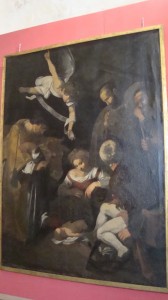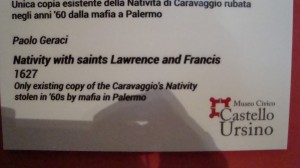It was reported last week that a facsimile of Caravaggio’s Nativity with San Lorenzo and San Francesco (also known as The Adoration) will be placed in the Oratio of San Lorenzo, the oratory where the painting on which it was copied was stolen in October 1969. After being displayed for about three-and-a-half centuries in Palermo, Sicily, the Baroque masterpiece was stolen and has not been seen since. Theories about its eventual fate (relocation or destruction) have circulated for years, but nothing is definitively known about its whereabouts except that it is believed that the mafia played a role in the disappearance. The high-resolution digital copy was welcomed last weekend by Italy’s head of state, Sergio Mattarella (a former judge whose brother was killed by the mafia).
But where is the original painting? Sadly, many stolen works are never recovered. As more time passes, it becomes more and more unlikely that art objects will ever be recovered. Some works are intentionally or accidentally destroyed. Works can sometimes be inadvertently damaged, however some thieves intentionally destroy their loot to avoid detection or culpability. For example, thieves and their accomplices have burned works, thrown them in the river, and shredded them in garbage disposals. In regards to recovery, law enforcement agents state that art thieves are almost never caught, with the FBI recovery success “below 10 percent.”[1] (Others opine that only 2-5% of art is ever recovered.) Interestingly, the values of works on the black market are drastically reduced, perhaps fetching about 10% of its estimated value on the legal market.
In the case of Caravaggio’s Nativity with San Lorenzo and San Francesco, a high-quality copy was placed in the original location of the stolen painting. High-quality replicas may soon play increasingly significant roles in art history as 3-D imaging is now being used to record details about at-risk objects in conflict regions, such as ISIL territories in Iraq and Syria or pillaged areas in India. Emerging imaging technology will help to fill in gaps and prevent loss of information due to destruction and theft of art objects.
(A copy that I was lucky enough to see this summer in Catania, Sicily.)
[1] http://www.bloomberg.com/news/articles/2015-06-15/what-happens-to-stolen-art-after-a-heist-

